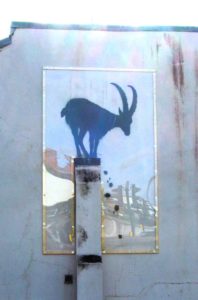
Banksy’s goat near Kew Bridge, Richmond (photo courtesy of Jim Linwood)
Last week, London became populated with stenciled animal silhouettes credited to the anonymous street artist Banksy. I initially thought he would stop on Friday with his duo of pelicans on the sign of a fish-and-chip takeaway. However, he continued over the weekend, finally stopping on Tuesday, August 13th.
Many were surprised on Saturday morning to find a large, black cat stretching across an empty billboard on the Edgware Road in Cricklewood. But after only a few hours, reports came in that the cat, like the wolf, had also been removed. But unlike the incident with the wolf, it seems no one stole the cat. A contracting company claims to have removed it to prevent it from being stolen or defaced. Some of the animals have met this fate, prompting the first in the London Zoo series, the goat near Kew Bridge in Richmond, to have a plexiglass panel placed over it. While the contractors removed the cat from the billboard, onlookers expressed their disapproval of the decision. The billboard’s owner, however, has commented that they plan on donating the cat to a gallery. Michel Boersma, a curator who has worked closely with Banksy, also spoke out against this move: “These street artworks need to be seen on their original locations, as intended by the artist.”
Starting on Sunday, though, Banksy’s animals became more than silhouettes. That day, Banksy painted a glass police sentry box to look like a fish tank full of piranhas in the City of London. The fish, however, were more than just black shapes. The box included blue, with gray and white detailing to show exactly what kind of animal this is. After the artist posted an image on his Instagram page, the box was quickly moved from its original location near the Old Bailey to a better location by London’s Guildhall, as it is more suitable for large groups of people who may want to visit the box. Authorities blocked off the sentry box with barricades to prevent it from being defaced or damaged. The next installation in the series was found on Monday in Charlton, in southeast London, consisting of a rhinoceros in a rather racy position in relation to an abandoned car. One commenter on Instagram wrote, “To be fair the Rhinos are running out of mating partners.” Like the fish the previous day, the rhino was not just a simple black silhouette. Banksy painted the animal in its natural gray with detailing in black. It didn’t take long, though, for the car to be removed and for another graffiti artist to tag the rhino.
It seems those who called this series Banksy’s London Zoo were onto something. The last day of the series consisted of a final stenciled work at the gates of London Zoo in Regent’s Park. This was the only work in the series with more than one type of animal. A gorilla with some detail in the face rather than just a silhouette is lifting the roll-up security gate at the zoo’s entrance to let out the animals. These include a sea lion, a variety of birds, and unseen animals whose eyes stare out from the darkness under the gate. With this final piece, Banksy tells a lighthearted story of animals escaping from the zoo and being found all over London. The zoo announced it is making arrangements to preserve the work. But there’s also a different message in the London Zoo series. Banksy is known for his thought-provoking work imbued with political or social commentary. For the entire duration of the London Zoo series, both art world specialists and the general public speculated as to the meaning behind each of the individual entries in the animal silhouettes. But Banksy’s agency, Pest Control, stated that “recent theorizing about the deeper significance of each new image has been way too involved”. I think the greater message is that although art can be used to convey profound messages, it is sometimes just as useful when it’s just for a bit of fun.
